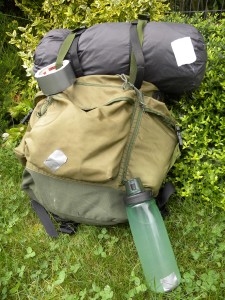Every time I see an article about backcountry travel that lists the classic ten essentials (first drummed into all northwesterners by the Mountaineers), I shake my head in disbelief. Map, compass, sunglasses and sunscreen, extra clothing, headlamp/flashlight, first-aid supplies, firestarter, matches, knife, extra food … all great things to have on any outdoor expedition, but there is one crucial element missing: duct tape. How could any intrepid outdoor type leave home without it? Duct tape has saved my feet, my equipment, my trip and my sanity more than once. It truly is a miracle product. Whoever invented it should get a Nobel prize.
 It’s true that excessive use of duct tape can give you a reputation, especially if you display it on everything you own. But these days, you don’t have to use the basic silver duct tape, which was designed to stick to plumbing pipes and ductwork. Nowadays this sort of household tape comes in all sorts of colors that you can match to your pack, tent, boots, jacket, whatever, so as not to appear the total outdoor geek, although packing around multiple rolls of duct tape might raise a few eyebrows. The colored tape is often labeled “duck tape,” which is a bit disconcerting to us writer types (is this promoting duck abuse?). The colored “duck tape” is not as sticky as the original duct tape, so I’m a classic silver tape gal myself, but if you’re appalled by the possibility of being confused with a plumber, you now have fashion options.
It’s true that excessive use of duct tape can give you a reputation, especially if you display it on everything you own. But these days, you don’t have to use the basic silver duct tape, which was designed to stick to plumbing pipes and ductwork. Nowadays this sort of household tape comes in all sorts of colors that you can match to your pack, tent, boots, jacket, whatever, so as not to appear the total outdoor geek, although packing around multiple rolls of duct tape might raise a few eyebrows. The colored tape is often labeled “duck tape,” which is a bit disconcerting to us writer types (is this promoting duck abuse?). The colored “duck tape” is not as sticky as the original duct tape, so I’m a classic silver tape gal myself, but if you’re appalled by the possibility of being confused with a plumber, you now have fashion options.
What can the intrepid (or even the clueless) outdoor type do with duct/duck tape? First and foremost, this is the best guard against blisters ever invented. Sadly, I learned this only after twenty years of blisters and cursing moleskin and band-aids. If you tend to get blisters on your heels while hiking, running, skiing, snowshoeing, etc., get in the habit of duct-taping your feet first and you’ll be amazed. Clean and dry those heels, apply a strip of duct tape to your bare skin, then slide your sock over it. Being a perfectionist, I cut little slits in the ends of the duct tape so I can overlap the ends and make the tape conform perfectly to my heel. However, I have small feet and if you have ubersize ones, you probably don’t need to do this—just smooth out the duct tape and go. It stays on my heels for ten miles or more, and peels off easily when I’m done. It would probably work on other foot areas, too.
Another important use is backcountry first aid. When you fall out of that tree you shouldn’t have been climbing, get out the duct tape. It works much better than regular adhesive tape for securing splints or gauze bandages. You can put a rectangle of duct tape over a dressing to keep it in place, stop that messy bleeding, and keep the dressing from sogging up rain. When applied to dry skin, duct tape hurts less to remove than most adhesive tapes. In a pinch, I’d even use it to bind together the bare edges of a gash. When my hiking buddy did a spontaneous backflip off a boulder (yep, should not have been climbing that) and broke her wrist, we made a split out of a sawed-up water bottle held together with duct tape. Duct tape can make up for a lot of inadequacies in your first aid kit.

Just grab the tape and get out there.
Then there’s the use that everyone thinks of first—patching equipment. You can patch pretty much anything with duct tape, although if it’s a big hole, you probably need to duct tape both sides so pieces of the tape stick to each other instead of to stuff you don’t want them to. Over the years, I have duct-taped packs, tents, mosquito netting, stuff sacks, sleeping bags, hiking boots, ski boots, kayaks, and even various pieces of my scuba gear. After dropping my favorite plastic water bottle and causing a microscopic ding that made water seep slowly out down my pants, I discovered a piece of duct tape would keep it from leaking water and save me embarrassment.
What else? Duct tape can substitute for a broken binding or strap, as in duct-taping your boot to your snowshoe. (Make sure you have a knife handy so you so don’t have to drive home in snowshoes.) If you abuse your hiking poles like I do—I’ve done a few spectacular vaulting maneuvers with them, as well as sitting on them and dragging them to slow down on steep slopes while cross-country skiing—or if you have the type that screw together to adjust, and like me, you never see that pesky STOP mark until you’ve pulled them irrevocably apart, consider bringing duct tape for a fix. You can often either slide a stick or pen inside a hollow pole or splint it with something rigid on the outside and then bind it with duct tape so you can continue misusing your poles until you get back to the car.

Me paddling my small kayak
Strips of duct tape can also be used to prevent wear and tear on parts of equipment that routinely get scraped up. I’ve been known to put strips on the hull of my kayak so that it doesn’t get so badly scratched when landing on gravel beaches or killing barnacles on rocks.
If I want to collect tiny seeds or sand to save for later examination (my outdoor geekiness escaping) and I’ve forgotten to bring zip-lock bags (again), I can press the seeds or sand into a fold of duct tape. You can similarly use duct tape to grab yucky stuff—extracting those annoying rodent droppings from your pack, for example.
There are many other uses for duct tape that I haven’t had the opportunity to employ yet, although they have (obviously) crossed my mind: curing snoring, taping young children to their seats, binding the hands and feet of criminals captured in the wild. (Just kidding about the first two. Sorta.)
Finally, if your clothes, like mine, just naturally attract every mammal hair in the vicinity, roll a strip of duct tape around your hand and pat yourself down before meeting your public. Take care to make sure you are not observed. Because, like I said, excessive use of duct tape can give you a reputation.
And, when buying duct tape, its like anything else — you get what you pay for. Don’t be cheap.
Amen, Carol. Plus, I find that duct tape doesn’t keep forever. Well, the rolls do, but after a few years, you can’t get the tape off. So it doesn’t pay to stockpile the stuff.